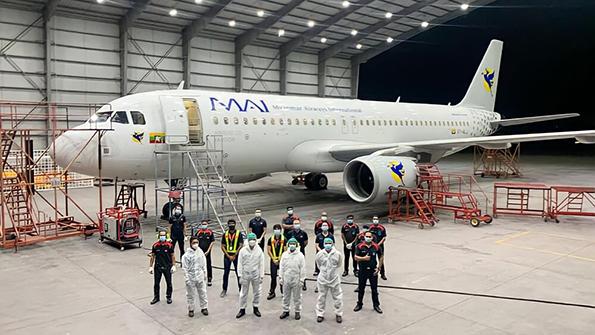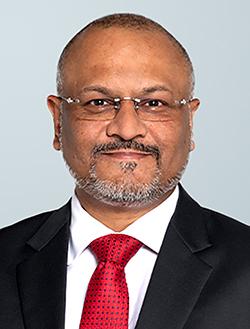
Despite the sluggish return to growth in the Asia-Pacific region, AirAsia
is making plans for long-term expansion with a series of new investments.
Javed Malik, the airline group’s group chief operations officer, discusses
why it is doubling down on digital services and why it set up an in-house
MRO business last year.
How has AirAsia ridden out the past 15-18 months, and what shape is the business in now?
Pre-COVID-19, we were the 11th-largest airline in the world by fleet size and the biggest in the Asia-Pacific region. The likelihood of surviving compared to others was good, but nobody would have expected nearly two years of this lockdown and the severity of it. The good news is that we’ve been able to stand on our own two feet and get through it. Fundamentally, this is because of our digital transition that allowed us to sustain the cost of running a corporation of this size with more than 13 lines of business. We are a different business now—very much a digital travel company rather than just an airline. If AirAsia had operated as just a standalone airline, we would likely have struggled.
A new maintenance business, Asia Digital Engineering (ADE), was formed by AirAsia last year. How will its formation change the overall maintenance strategy of the airline?
It began to take shape pre-COVID-19, when we looked at the digital journey we wanted to be on and what sort of products and services we could offer. When we reviewed the spaces of aviation and digitalization, we saw that there is a lot on the engineering side where technology could play a larger role. We felt that with our analytics and predictive capabilities in place along with mobility in our workforce, we could explore creating a low-cost carrier equivalent of a maintenance offering. Out of that was born Asia Digital Engineering.
Apart from the digital and analytics opportunities, as the largest carrier in the region with more than 250 aircraft in the group at the time, we have a huge demand for MRO that is never fulfilled by our provider partners around this region. Whether it’s in Indonesia, the Philippines, Thailand, Singapore or even India, we couldn’t find enough companies to take on our volume. Ultimately, we felt that long-term, we needed to manage our own maintenance at least up to the heavy checks at C level, which is our largest cost element, and maybe eventually D checks.
Another big cost element is related to spare parts, consumables and rotables of aircraft. As the world’s largest GE engine operator with many Airbus aircraft, we had a huge pool of consumables and rotables across the same aircraft type. While having a single aircraft type policy is good for cost of ownership and spares, it also means we have a lot of spares, some of which were being used while others were running out. We thought that if we could aggregate this pool—these spares that are expensive—with technology like blockchain, then maybe we could create a marketplace ourselves and recover revenue for products that cost us money many years ago.
The business is predominantly covering the AirAsia fleet initially, but will it look for more third-party work long-term?
Absolutely. We’ve secured three cus-tomers already that we are servicing for basic line check-related activities. The aim was to grow it as a provider open to everyone—like our AirAsia.com app, where you can buy Cathay Pacific and Malaysia Airlines tickets. Our aim was to serve anybody, subject to licensing requirements for the MRO business. We obtained the licensing clearances from the regulator for line checks, technical checks for not just the Airbus fleet but also for third parties as well. The intention was to always maximize use of our down time—AirAsia’s peaks and troughs are well-defined with our network and schedule. We know we have the capacity during the troughs to provide and sell services to others.
The airline grounded around 90% of its fleet of more than 200 aircraft across Asia at the height of the pandemic. What are some of the planned fleet changes AirAsia is implementing?
We had around 260 aircraft pre-COVID-19. We’ve hibernated 220-230 aircraft, and we’ve kept 40-45 aircraft rotating every day. These have been rotated out of the larger fleet, however, so we are not working just a few aircraft to death and can spread the hours and maintenance on those. We’ve deployed different strategies—but at best, we’ve had about 20% of the fleet operational, with the other 80% being grounded for three months to more than one year. The majority of the aircraft have been kept in Kuala Lumpur, with a few spread into the Philippines and Indonesia, where the maintenance for those specific aircraft took place.
Will you look to insource certain services, or do you foresee AirAsia outsourcing more of its maintenance requirements in the long term, considering the growth of the ADE business?
We are of the mindset that we can outsource a lot more of our mainte-nance, but our outsourcing will be through partnerships, joint ventures and mergers and acquisitions, so we still have ownership of the technology, data and cost base. We won’t be outsourcing it to a pure third-party service ultimately. ADE has a long way to grow to become a strong MRO player in this region. It has a wealth of engineering experience on aircraft operated by AirAsia, but to be able to provide the scale the airline needs, the C and D checks require lots of lines of work and hangar space for long periods of time. If we were to tie up ADE just for these tasks, then our line maintenance work wouldn’t get done and that would have to be outsourced. We’ll ultimately partner with our MRO providers and they’ll do the work, as we have done for many years. Our relationships with our partner MROs won’t simply disappear because ADE exists. We are planning on taking a balanced approach.
What are some of the digital investment opportunities AirAsia is seeing?
There are several categories for new digital services. First, the transactional space of e-procurement. There is a lot of opportunity in terms of consumables, rotables and selling in a marketplace for anybody that needs to buy in the Asia-Pacific region. We aren’t looking to go global in this business—there’s enough demand and volume in this region where we can offer economies of scale, and our scale to buy in volume allows us to sell OEM parts and consumables at a different level. That’s a bundling offer we can do with our services that other MROs may not be able to compete with, as they don’t have the scale that we do. Given the nature of consumable spare parts and aircraft sensitivity, there needs to be strong governance and control over that process. That’s where we see products like blockchain coming in to help create a secure environment. We’ve already created a marketplace product in-house that deploys elements of blockchain.
Another area we have done a lot of work in is the prediction space, where we can build algorithms suited to our engine and aircraft type performance. Our data team has built specific algorithms coupled to attractive and smart, sensible dashboards that we believe we can now monetize and offer as data services for other carriers who do not have 18 years of data. Our data about performance of our aircraft fleet has produced more than $120 million of savings on our fuel performance alone over the past five years or so.
The third pillar is the use of drones for aircraft maintenance. We’ve licensed and registered a drone business, we’ve started a drone school for training, and we see the first use of that capability in the engineering area for monitoring aircraft fuselage damage and cracks.
AirAsia Fact File

History: AirAsia was founded in 1993 by Malaysian government-owned conglomerate DRB-HICOM and commenced operations three years later, in 1996. In September 2001, the heavily indebted airline was acquired by businessmen Tony Fernandes and Kamarudin Meranun. The partners soon made the airline profitable and continued to expand the operation across new hubs, while adding new routes. New subsidiary airlines were established in Indonesia, the Philippines, Thailand and India, while a long-haul low-cost carrier, AirAsia X, was launched in 2007.
Fleet: AirAsia Group operated an all-Airbus fleet of more than 250 aircraft across its airline businesses pre-COVID-19. During the crisis last year, it operated around 20% of its fleet.
MRO Capabilities: Asia Digital Engineering (ADE) was set up in September 2020 as the new MRO unit of the AirAsia Group. Its offerings include line maintenance services and component repair and overhaul capabilities for wheels and brakes, oxygen bottles and batteries. In May 2021, it obtained regulatory approval from the Civil Aviation Authority of Malaysia to conduct base maintenance activities. Other services include inventory and warehouse management, fleet technical aircraft management, CAMO services and technical consultancy.
